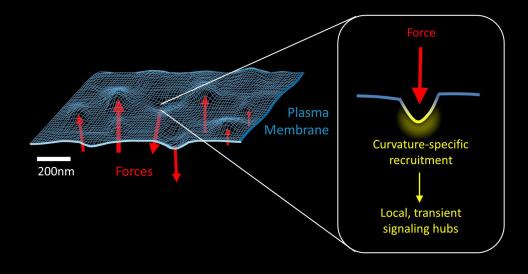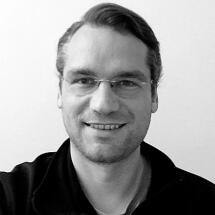Prof. Dr. Milos Galic
Control of cell migration and architecture via mechano-chemical signal translation

Biophysics
Cell Biology / Molecular Biology
Neurobiology
Work in our lab is focused on a particular type of receptor-independent signaling platforms, where mechanical forces at the plasma membrane are translated into classical biochemical signal transduction cascades via nanoscale membrane deformations (see Figure). This type of mechano-chemical signaling is believed to contribute among others to cell architecture (e.g. neuronal arborization), directionality and speed of cell migration, as well as collective cell behavior. Yet, despite its importance, the underlying mechanisms have largely remained unclear.
To investigate the molecular mechanisms, our lab uses an interdisciplinary approach. We combine cell and neurobiology with biophysics, nanofabrication and computational analysis of microscopic images. Together, these studies will advance our understanding how forces acting on the cell surface contribute to cell function or affect various tissue properties.
Possible projects for a PhD thesis are among others:
1) Spatio-temporal analysis of curvature-dependent protein/membrane interaction.
2) Analysis of curvature-dependent regulation of actin-based forces in live cells.
3) Investigation of curvature-dependent regulation of neuronal architecture.

Vita
- 1996 - 2002: Studies in Biology, University of Zürich, Switzerland
- 2002 - 2007: PhD in Neurobiology, University of Basel, Switzerland (summa cum laude)
- 2007 - 2012: Postdoctoral Fellow, Chemical & Systems Biology, Stanford University, USA
- 2012 - 2013: Research Associate, Chemical & Systems Biology, Stanford University, USA
- Since 2014: CiM Junior Research Group Leader, Medical Physics & Biophysics,
University of Münster, Germany - Since 2022: University Professor, Medical Physics & Biophysics, University of Münster, Germany
Selected references
Mancinelli, G., Lamparter, T., Nosov, G., Saha, T., Pawluchin, A., Kurre, R., Rasch, C., Ebrahimkutty, M., Klingauf, J. and Galic, M. (2021). Dendrite Tapering Actuates a Self-Organizing Signaling Circuit for Stochastic Filopodia Initiation in Neurons. PNAS 118(43)e2106921118.
Mancinelli, G. and Galic, M. (2020). Exploring the interdependence between self-organization and functional morphology in cellular systems. J Cell Sci, 133(13):jcs242479.
Begemann, I., Saha, T., Rathmann, I., Grill, D., Golbach, L., Rasch, C., Ricker, A., Trappmann, B., Matis, M., Gerke, V., Klingauf, J., and Galic, M. (2019) Mechano-chemical self-organization determines search pattern in migratory cells. Nat Phys, 15,848-857.
Viplav, A., Saha, T. Huertas, J., Selenschik, P., Ebrahimkutty, M. P., Grill, D., Lehrich, J. Hentschel, A., Biasizzo, M., Mengoni, S., Ahrends, R., Cojocaru, V., Klingauf, J., and Galic, M. (2019) ArhGEF37 assists Dynamin2 during clathrin-mediated endocytosis. J Cell Sci, 132: jcs226530.
Saha, T., and Galic, M. (2018) Self-organization across scales: from molecules to organisms. Phil Trans R Soc B, DOI 10.1098/rstb/373/1747.
